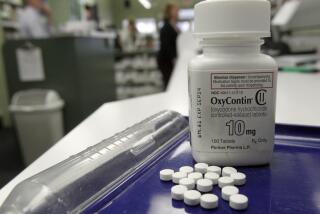Drug Guidelines Fatten Bottom Lines
- Share via
Just three years ago, updated cholesterol guidelines almost tripled the number of Americans for whom cholesterol-lowering statin drugs are recommended to 36 million, or one out of five adults. Statins overtook antidepressants as the best-selling class of drugs in the United States, and the new guidelines promised to add more than $20 billion to drug company coffers each year.
Many of the additional people for whom statins were recommended did not yet have heart disease but were at moderately high risk and had LDL, or “bad” cholesterol levels, above 130 milligrams per deciliter.
This month, the recommendations were updated again, and millions more Americans with LDL levels between 100 and 129 found themselves in a new risk category.
Based on the results of five new studies, the experts from the National Cholesterol Education Program recommended offering these people the “therapeutic option” of taking a statin drug. What sensible person would forgo this opportunity to ward off heart disease?
But are the lower targets justified? It’s not so clear. One of the new studies included 2,000 women with four or more risk factors for developing heart disease. Unexpectedly, the women randomly assigned to take the statin Lipitor developed slightly more heart disease than those given placebos.
Still, one study shouldn’t negate the findings of the six earlier ones cited in the 2001 guidelines. But a closer look reveals that not a single one of those studies actually provides significant evidence that statins protect women who don’t already have heart disease. Although millions of women are already taking statins, there is still no evidence from “gold-standard,” large, randomized controlled trials to show they help.
Another of the new studies included 3,000 people between the ages of 70 and 82 at high risk of, but still without, heart disease. Treatment with a statin drug did not significantly reduce their risk of heart disease either. But it did significantly increase their risk of developing cancer -- by 25%. Again, this single study shouldn’t negate the nine studies cited in the 2001 guidelines as evidence that statin therapy protects people over 65 from developing heart disease. But, again, when each of the nine references is examined in detail, not a single one provides significant evidence that statins help protect those without heart disease.
Still another of the new studies, one including 10,000 people at risk of heart disease, showed that tripling the number of people taking statins -- as called for in 2001 -- provided no additional benefit, except for blacks, who had fewer episodes of heart disease but no fewer deaths.
In the face of this non-evidence, why are these new government-sanctioned guidelines so staunchly pro-drug therapy? No conflicts of interest in these latest recommendations were reported, nor were any reported in the three major newspapers that headlined the story. But the National Institutes of Health later posted financial disclosures on its website: Eight of the nine authors have or had financial ties with drug companies -- with an average of seven companies each. One of the authors, a full-time federal employee, disclosed ties to 10.
These experts are focusing doctors’ and patients’ attention on the wrong question. The real issue is not how statins should be used to lower LDL cholesterol, but which patients without heart disease get any benefit at all from statins. The real evidence, which won’t sell many drugs, shows that statins don’t benefit women and probably harm people over 70 (except those with diabetes). Even for men under the age of 65, statins reduce the risk of heart disease but probably not the risk of serious illness from all causes. And while giving lip service to “therapeutic lifestyle changes,” these new recommendations downplay other evidence that a healthy diet, regular exercise, not smoking and blood pressure control each provide more protection than lowering cholesterol with a statin.
The ongoing pro-drug bias in these enormously influential recommendations provides a window into understanding how the U.S. may be spending more than $500 billion each year on medical care that is not helpful and often harmful to health. The real crisis in American medicine is not about cost but about the quality of our medical information.
John Abramson MD, a Harvard Medical School clinical instructor, is author of the forthcoming “Overdo$ed America: the Broken Promise of American Medicine.”






